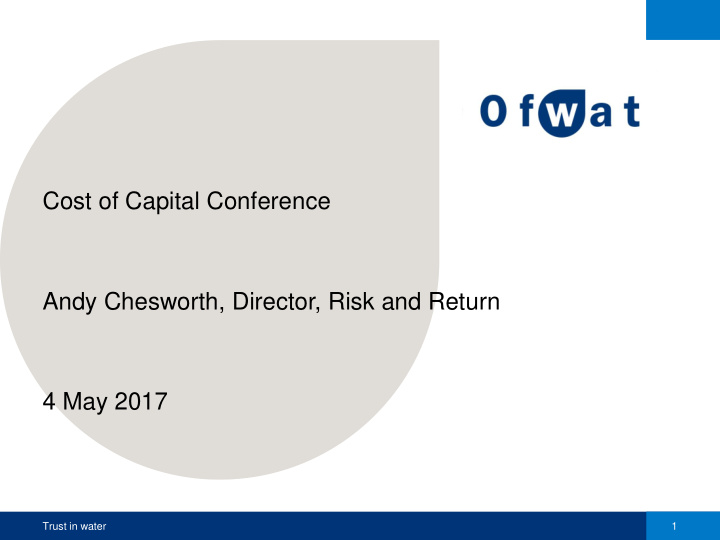



Cost of Capital Conference Andy Chesworth, Director, Risk and Return 4 May 2017 Trust in water 1
Progress towards PR19 – what we have done and what is still to do? We have already decided some key elements of the regulatory The PR19 methodology will set out further detail of our framework regulatory approach. • Strengthened approach to customer engagement and outcomes • CPI/CPIH indexation of price/revenue controls and the RCV In particular our expectations of what we expect to see in • Separate binding price controls for water resources and company business plans, how we will assess those business bioresources (and the broad outline of how these controls will plans and our approach to intervening if companies do not operate) submit good business plans. • Information platforms for water resource and bioresource markets This will cover our approach to individual elements of the price • Greater use of markets in the financing and provision of new control such as affordability, resilience and financeability. assets by third parties (direct procurement for customers) May - Regulatory Oct/Nov – Cost of debt Jul – PR19 Methodology framework decision approach and Dec – Final PR19 Consultation Sep- Business consultation on Methodology Plan outcomes and licence Indicative RoRE range Submissions changes and indicative cost of Dec – Final Key deliverables Jan – Initial capital determination assessment Dec – PR16 final of business Jul – Draft plans determinations determination 2016 2017 2018 2019 Regulatory PR19 Methodology Business plans Draft and Final Determinations framework Q1 Q2 Q3 Q4 Q1 Q2 Q3 Q4 Q1 Q2 Q3 Q4 Q1 Q2 Q3 Q4 Trust in water 2
Cost of capital - macroeconomic context – ‘lower for longer’ OBR forecasts on UK interest rates 10-year forward rate for 10-year government gilts OFFICIAL – SENSITIVE - COMMERCIAL Trust in water 3
Cost of equity – Market to asset valuations Analyst quotes: Credit Suisse: “The challenge for UK utility companies is that capital is oversupplied and returns have fallen to low levels. Whereas c10-20% post-tax nominal equity IRRs were achievable across 2008-13, we think those have now halved in recent years. ” Macquarie: “We estimate baseline RORE at 4% real, in line with our current cost of equity (7% nominal at 62.5% leverage). This would already be the lowest allowed regulated RORE in the UK since privatisation and is lower than the CMA determination of the cost of equity based on long-run beta, risk free and ERP calculations .” Trust in water 4
Cost of debt Trust in water 5
Cost of debt – indexation mechanism September 2017 consultation • Considered principle of debt indexation; not detailed mechanics • Proposed index cost of new debt only; embedded debt set in similar manner to the past • Preference for end of period true up adjustment • Debt indexation based on nominal index, adjusted for outturn inflation Outcome • Majority of consultation respondents either supported debt indexation, or gave conditional agreement, depending on the detailed mechanics • Concerns about treatment of inflation Workshop – January 2017 • Considered possible mechanics of cost of debt mechanism • In period vs end of period adjustments • Calculation options - debt profile for the notional company, calculation of applicable interest rate • Index choice – tenor, options - iBoxx corporate non-financial, iBoxx utilities, Bloomberg, BoAML Corporate / non-gilt • Inflation adjustment – outturn, breakeven inflation, Bank of England inflation target • Takeaway message – simplicity, transparency, legitimacy Next step – Consultation proposal - July Trust in water 6
Managing risk and uncertainty • All businesses have to deal with risk and uncertainty in operating and planning their activities • As with PR14, we will apply a high evidential bar where companies propose uncertainty mechanisms at PR19, given the risk mechanisms implicit within the controls Within a price settlement 1 Totex cost 2 3 Use of inflation All of these reduce companies’ 5 year price sharing and in price exposure to unexpected controls special cost variations in costs and/or controls factors revenues by allowing some of the unexpected variation onto 4 customers through changes in Possible 4 6 5 bills Outcome mechanisms Revenue true Delivery ups for tax and Incentives cost of debt Possible issues for PR19? • Potential issue in regards to timings of development of National Environment Plan National • Both EA and NRW are working with companies to manage issues associated with uncertainty that Environment the different planning cycle brings Programme • Timing of the business rates revaluation in PR14 cycle meant that uncertainty mechanism was Business created for all companies rates • Currently not clear that the level of uncertainty is as great as PR14 • The UK will continue to be bound by EU law until it is no longer a member. Brexit Trust in water 7
CPI or CPIH? In May 2016 we said we would transition from RPI; companies accepted the licence modification necessary to move away from RPI. We have committed to determine whether the transition will be to CPI or CPIH by January 2018. Since May 2016 several relevant factors have changed: • The National Statistician stated intention to work towards designation of CPIH as a National Statistic as early as possible • CPIH is now the ONS’ headline measure of inflation and the focus of its inflation commentary • The UKSA not yet conferred CPIH as a National Statistic but reconsidered at 25 April Regulation Committee meeting • Some (limited) issuance of CPI linked debt: – £100m by MGT Teesside, – £40m in two tranches by UUW and – £210m by Banks Renewables Trust in water 8
Recommend
More recommend